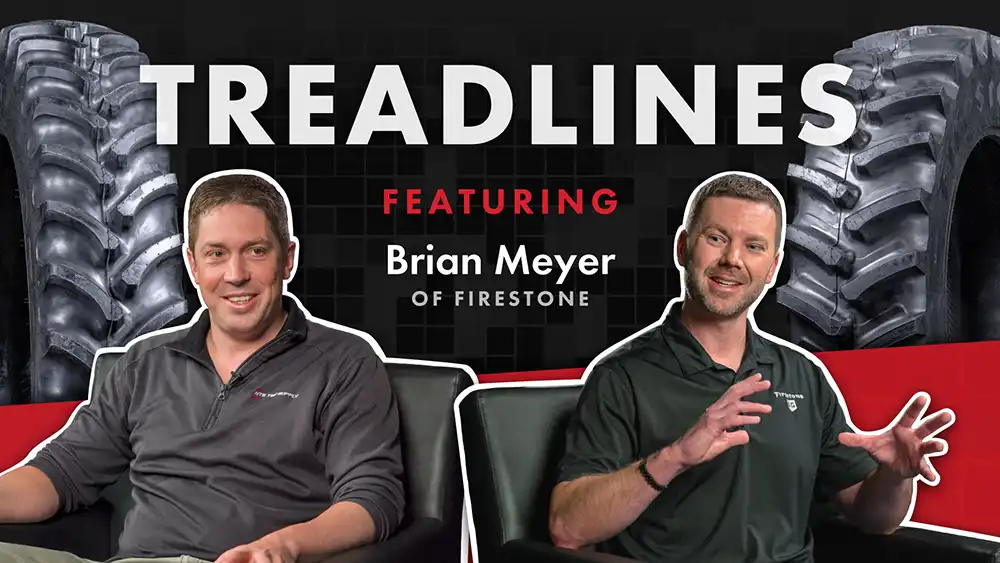We don’t hear the question often, but we do hear it: Should I throw a tube in my tractor tire to help guard against leaks? In a way, this logic makes sense. The tube is giving you an extra layer of protection, right? Maybe a tube will keep me working if I get a deep cut in a tire?

These are valid questions, but the answer is simple: Unless you’re outfitting vintage equipment, it’s best to go tubeless 99% of the time. With modern tractor tires, inner tubes are more useful for recreation than field work.
Tubeless Tires: They’ve been Around a Long Time
Tire manufacturers first developed tubeless tires in the 1970s. Today, you’ll find tubeless tires on nearly all farm machinery. It’s easy to identify tubeless tires as they include “Tubeless” on the sidewall somewhere. If a tire doesn’t say “Tubeless” on its sidewall, you’ll need to use a tube. Otherwise, you’re asking for an immediate tire failure.

Do Tube Tires Offer an Additional Layer of Leak Protection?
Not really. Long ago, every tractor tire was a tube tire. Today, outside of certain specific applications, inner tubes are best pulled behind a boat or pushed down a snowy hill. When punctured, a tube tire will go flat almost immediately. Then you’ll face the issue of repairing the tire. First, you have to remove the tube from the tire. Think about some of your equipment—a planter for example: it may be hard enough to crawl underneath and plug a tire. Now imagine having to crawl underneath and wrangle the tube out of the tire, then try to stuff a new one in.
And once you do buy a new tube, you have to install it correctly. If it gets pinched, or if any foreign material sneaks into the tire when it’s off the rim, you could be in for another flat tire sooner than later. If the inside of a tire has any developing cracks, they can eventually become large enough to pinch the tube. Plus, inner tubes aren’t a good fit with modern radial tires. Radials’ sidewalls are designed to flex in order to provide a larger footprint for traction and a better ride for roading. A flexing sidewall can easily pinch and damage a tube as well.
The (few) Advantages of Tubes
Tubes do have an upside or two. For one, it’s easier to seat the bead on a flat tire with a tube. It can also help in cases where a tire has a bent bead. Additionally, some farmers swear by tube tires for working steep hillsides—you may experience fewer issues with tires coming off their beads during these applications when you utilize tubed tires. You can also use an inner tube to fix a slow or hard-to-find leak on a tubeless tire.
In fact, when we sell used tires at NTS Tire Supply we may specify that specific used tubeless tires need tubes. These are tires that may have some service life left but have aged casings or a (really) slow leak.
Tube or Sealant?
When it comes to fixing a pesky leak in your tractor tire, or guarding against leaks and minor tire damage, it often makes more sense to invest in a high-quality tire sealant than an inner tube. At NTS Tire Supply, we offer Orange Armor, which is easy to install in your tractor tires using the hand injector pump. You don’t need to dismount or even deflate a tire to install. Simply drive slowly for a short distance or rotate the tires a few times after installation to completely coat the inside of your tires. Orange Armor won’t settle to the bottom of a tire when parked and won’t harm the wheel or rubber. In fact, it’s water soluble; if you have to repair a tire, you can easily clean the tire to complete the repair, then reapply Orange Armor, which will last for the life of the tire. With this technology available, there’s rarely a time when you need to turn to a tube to fix or guard against air leaks.
Why You Need to Go Tubeless 99% of the Time
Sure, there are disadvantages to tubeless tires. To air up a tubeless tire that’s gone completely flat, you might have to jack up the tractor to reset the bead seal. In certain applications, such as operating on steep hillsides, the bead may break loose easier on a tubeless tire. (A simple way to help avoid this problem is to put a few more pounds of air into your tires. But make sure you never exceed the maximum inflation pressure printed on the tire.)
Corrosive tire ballast can damage your rims easier on a tubeless tire. (To be fair, corrosive ballast can also eat through an inner tube. Then, you have two problems to deal with.) But even this has a solution—Bio-Ballast—a non-corrosive tire ballast that actually helps extend the life of your tire and wheels!
You can easily deal with these disadvantages. When mounting tubeless tires, use a bead sealer (not soap) to ensure a better seal. Punctures and cuts, which can cause immediate flats on tube tires, will result in a slower leak on tubeless tires. You can fix some punctures with a plug or Orange Armor, for which you don’t have to remove the tire. And if you want ballast but are concerned about corrosion damage, Bio-Ballast, available at NTS Tire Supply, can help you gain traction and pulling power without the harmful side effects of calcium chloride.
Tubeless tires have been around a long time, and with modern radial farm tire technology, there are few (if any) reasons to resort to tube tires. For most applications, it’s better to save the tubes for the lake.

.png)
.jpg)



















